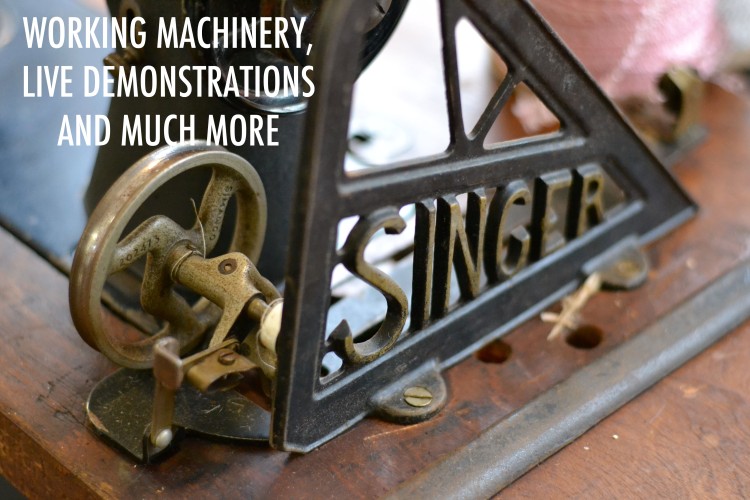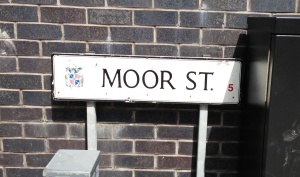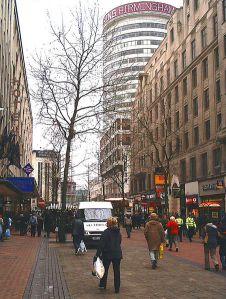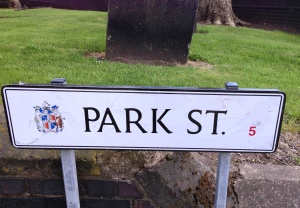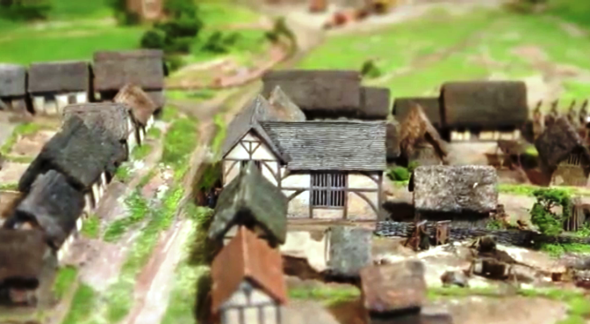Chris Upton – Bridging the Gap
Posted: October 1, 2017 Filed under: Uncategorized Leave a commentBeing asked to give the inaugural Chris Upton Memorial Lecture was both an honour and privilege. There were many other people who could have been asked to give the first lecture, so this was a truly humbling experience and one of those occasions that made me prouder than I can ever express. That said, I did feel the great weight of responsibility. But, in true Chris style, the rules were straight forward: keep it simple, but informative, unstuffy and most importantly, fun.
The theme of the Chris Upton Memorial Lecture was public history, largely focussing on how Chris bridged the gap between professional and public forms of history, and most importantly, how he made it fun. He was after all, the ‘people’s historian’. For him, telling a story, communicating that story to the public and making it as entertaining as possible was a vocation, it was his gift. It just so happens that the stories he told were all based on fact, not fiction. Well, for the most part, that is.
Not your average historian
I first met Chris in 2005, when I was working at Museum of the Jewellery Quarter, but the fondest memories I have are working with him on the Literary Bus for three consecutive years between 2010 and 2012. This is where I got to know Chris and his passion for using history to entertain the public. He could take straight-laced fact and turn it into pure entertainment. The basic premise of the Literary Bus involved a coach full of passengers travelling around the city, making stops at places of literary significance, with key characters from various books boarding, and well, colliding with the present and the past, depending on who they met along the way. Chris had an imagination, because only he could conceive of a stage where Rip Van Winkle crossed paths with Dr. Samuel Johnson, which culminated in Dr. Johnson chasing Rip around the grounds of Soho House Museum!
If you’re curious about the literary connections here, Rip Van Winkle is a short story published in 1819 by American author, Washington Irving, while he was living in Birmingham. But he is perhaps better known as the author of The Legend of Sleepy Hollow. Dr. Johnson was an English writer and critic, who just so happened to marry a Birmingham lass, but even this didn’t quell his disdain for the town, calling all Birmingham inhabitants ‘boobies’. If all this sounds crazy, it was, but that’s what Chris did: he allowed history, drama and imagination to collide, and when they met, it was the workings of pure genius. This was public history at its best.
Public history versus professional history
But what exactly is public history, and how does it differ from professional history? Let’s first start with professional. This refers to the academic world of universities for the most part, where trained historians critique the past, devoid of emotion, striving for objectivity. In contrast, public history can be defined as that which appeals to the masses – the types you find in museums and heritage organisations, or the types of history you might experience in a documentary for television. Often here, memory and emotional connections shape people’s perceptions of the past, so it’s deemed to be subjective. There’s a wealth of literature published on both, which often revolves around the conflicts that exist between the two – the conflicts that is, of those who supposedly seek an objective truth, and those who allow memory and emotions to shape their views of history. But the two aren’t mutually exclusive and they can work together. For museum professionals, public history is one of our biggest assets, because our emotional connections to the past often govern our interest in the past in the first place.
Public history is simply another type of record, another form of historical evidence, which of course has its flaws, but its strengths are far greater. Chris appreciated this and it’s fair to say that he strove to bridge the gap between the two disciplines. Connection is key in public history and ‘doing’ public history well isn’t easy. The public can be your biggest critics, but they can also help you improve your work, and become your biggest supporters. Public history can colour the past in a way that a secondary source can’t – it breathes life into it, it gives it shape, albeit an imperfect one, but perhaps more importantly, it gives it personality, making it gritty and honest.
Chris also understood that the public are the biggest consumers of history, the biggest consumers of the past – bigger than the academic world, bigger than ‘that’ professional world, so why be sniffy about public history, about engaging with the public? This is not to say any history would do for Chris – for him it was still based on rigour and research, on using primary sources in places like archives, and we all know how much Chris loved a primary source. Chris understood that history belonged to everyone, and that you don’t need a degree to appreciate history, you just need a past. This isn’t to devalue the discipline of history -I myself am a trained historian – but professional historians should view the public as a resource in its own right, a resource that can enrich their own work.
Civil Experts

Literary Bus passengers enjoy a stop at Blakesley Hall, with Chris doing what he did best: entertaining the public.
Research shows that the public’s interest is often governed by three key issues: the role of direct emotional connection, the relevance of real places and family history. One challenge for the public historian is to present an accurate, yet lively account of the past, and implicit in this is being able to tell a good story. A project that demonstrates Chris’ understanding of this and his ability to tap into the very essence of public history is his work on the Birmingham Back-to-Backs, which is very much one of his legacy projects. Elizabeth Perkins, former director of Birmingham Conservation Trust, who led the project, credited Chris with the narrative he created, and the intricacies of the stories of real people that he brought to the fore, both of which allowed people to connect with the history of Court 15. And it’s those stories that have made the museum as popular as it is today. According to Chris, one of the biggest resources for creating the museum and his subsequent book, ‘Living Back-to-Back, was,
‘based on memories from people who had lived in them, letters and phone calls, donations of artefacts, family photographs, copies of carefully researched family trees. Few of the letters related specifically to the families who lived in Court 15, but they were part of a communal memory of which court 15 was the catalyst. It was everyone’s history that was being projected.”

Women talking in courtyard of a Birmingham back-to-back, circa late 1950s© Chris Upton, Living Back-to-Back.
As Chris says, it didn’t even matter that the many letters he received didn’t relate specifically to Court 15 – they were part of a collective history of lived experience that helped create an important narrative. At a recent conference I went to, there was a speaker who had used the phrase ‘civil experts’ or ‘civil heritage experts’, which helps explain how Chris put the public’s memories to good use. So, in relation to the Back-to-Backs what does this mean? Well, the civil experts in this case are the people who actually lived in them, the people who lived in Court 15, the people who know the intricacies of living in those exact houses. They know how it felt to walk up the narrow stairs, to share those two toilets with those eleven families, to walk on, or hang their washing out in that exact cobbled courtyard in those particular months and years – the summer of 1976, or the great freeze of 1963. Yes, historians could write a contextual past, but it’s that lived experience, that level of intimate detail that means that nobody is better placed to tell you how these places were used and lived in, than the civil expert. And that is the type of history that brought the Back-to-Backs to life and why it’s been such a success ever since. Chris knew which notes to play – he knew how to connect to the public and what would resonate with them.
It wasn’t that it was even a particular mission of Chris’ to reach out to the public because that was somehow the right thing to do. He just didn’t understand why you would limit your audience when you could reach out to as many people as possible, in the books that you write, the tours that you lead and the talks that you give. But because Chris chose to write for the masses instead of solely for the ‘elite’, his academic journey was perhaps harder than it should have been, which he perfectly summed up below:
“When I was interviewed for my professorship four years ago, I was told that I had probably sold more history books than the rest of the panel combined – a panel that included two professors, a university vice chancellor and a college principal – but because the majority were published by Phillimore, they didn’t count.”
Chris’ work as a public historian somehow didn’t count, because it wasn’t peer reviewed, and yet he got the endorsement and support of thousands, a majority, rather than the sanction of a few. But that is the system. Chris could have confined himself solely to the academic route, but I think that went against the grain of what he truly believed – that history belongs to everyone and making it elitist simply closes down the conversation and the many possible connections.
Knowing your own history
Chris wrote the first single-volume history of Birmingham for half a century, and in doing so, he unearthed, even resurrected aspects of the city’s history that had either been forgotten, or never realised by many. There was a massive gap in the market, because even Brummies didn’t know their history. Chris’ A History of Birmingham was a revelation for me the first time I read it – in many ways it felt like fiction because there was so much that I didn’t know about my own city. For instance, how did I not know that Charles Dickens gave his first public reading of A Christmas Carol in Birmingham in 1853 at the Town Hall? I read A Christmas Carol at school for the first time in 1997. I was twelve and this fact would have inspired not just me, but a whole class. It would be another ten years before I’d learn of this fact when I read Chris’ book for the first time. Incidentally, Dickens opened the reading of a Christmas Carol in 1853 by saying,
“Ladies and gentleman—I have said that I bear an old love towards Birmingham and Birmingham men; let me amend a small omission, and add Birmingham women too. This ring I wear on my finger now is an old Birmingham gift, and if by rubbing it I could raise the spirit that was obedient to Aladdin’s ring, I heartily assure you that my first instruction to that genius on the spot should be to place himself at Birmingham’s disposal in the best of causes. I now have the pleasure of reading to you tonight A Christmas Carol in four staves.”
Now that’s a quote that gives you goose pimples. But why have we never shouted from the rooftops about our great history in this city? I’d never been able to put my finger on it, but Chris summed up why so many of us, and therefore the rest of the country, don’t know about the history on our doorstep:
“At some point in the early 20th century, Birmingham decided to demolish the past…it was entirely in harmony of an image cultivated over a century or more. There was a city and people more interested in tomorrow than yesterday: brash, energetic, frantically astute and innovative. Even her coat of arms bore the legend ‘forward’. As new ideas and technologies advanced, Birmingham was first on the bandwagon, energetically moving forward. The past needs time and contemplation, and Birmingham was in too much of a hurry for such niceties.”
Chris reminded us that we need to slow down, stop and reflect. Knowing your history – not just our successes, but where we we’ve gone wrong, seems even more relevant of late. You really do need to know where you’ve been to realise where you don’t want to go again. Chris, in so many ways relit the torch for us, and we owe it to him to not let it go out again.
Speaking Russian
The last conversation I had with Chris was in the summer of 2015. A production company had approached me and asked if the Coffin Works would appear on television, focussing on the Birmingham canals. Chris had helped me once before in 2010, when I was asked to do my first television interview at Museum of the Jewellery Quarter, talking about the exact same thing. On this second occasion, I remember talking to a couple of the Newman University students, who were on placement with me at the Coffin Works, and saying something like, ‘Oh I wish Chris could help me – he would be far better at this than me’. Martin, one of Chris’ students said, ‘well, let me call him for you – I’m sure he’ll be up for it’. In that moment I was touched that someone was so willing to help, but more so by the fact that Chris’ students could so easily feel that they could contact him. That’s what Chris did effortlessly – made himself so accessible, and in the true style of any great teacher, it wasn’t just his subject that he loved, it was joy of sharing knowledge and helping others to achieve that set him apart.
Needless to say that Chris agreed to take part, but that isn’t why I remember the conversation. I’m not sure why it even came up, but during that telephone call Chris told me that he spoke Russian, and even more impressively, that he’d read War and Peace in Russian. I genuinely thought I’d misheard. I was intrigued and asked Chris, why Russian out of all the languages he could have learned. And he said, “well Sarah, you have to remember that I grew up during the Cold War, and my teacher said, ‘if we don’t talk to them, we’ll never make it better’”. It was one of those moments that could have come straight from a film or a book, but it perfectly summed Chris up. He was always so willing to learn, so willing to communicate and he spoke many languages – he was truly multilingual, and I don’t just mean because he spoke Russian. He spoke the language of his students, the language of museum professionals, and the distinct language of the general public, and the many dialects in between. That is why we haven’t just lost a great historian, we’ve lost a great communicator, who could translate the past to anyone who was prepared to listen. But Chris’ biggest legacy is that people are still so willing to listen to him now – he continues to inspire and his voice is still heard, and that is a legacy that most of us can only dream of.
Click here to watch the Chris Upton Memorial vlog here:
Sarah Hayes, November 2016
Letters, lies and crossing the picket line
Posted: September 4, 2015 Filed under: Uncategorized 2 Comments1894 was a good time to enter the coffin-furniture trade, but what you won’t often hear is that it was a dangerous time. And not because of industrial accidents or poor working conditions. This was a well-organised and tight-knit industry where outsiders were not thought highly of or easily admitted.

© Newman Brothers. Staff at Newman Brothers in 1912, maybe even including some of the workers who went out on strike in 1897.
In fact, by 1888 admission to this exclusive group was strictly regulated and you needed just two things in common: to be master coffin-furniture makers and second, to ‘doff your cap’, or sell your soul, as others saw it, to the reigning organisation known as the ‘Alliance’.
The Alliance was a group of manufacturers with mutual interests, whose main aim was quite simple: to regulate trade and stop competition. Its underlying means of getting things done, was based on manipulation, corruption, threats and sometimes, it seems, even violence.
The Newman Brothers
Why did Alf and Edwin Newman then, voluntarily choose to enter this unscrupulous world, actively making the move from brass founding to coffin furniture production? They must have been aware of this group and the influence they possessed. But, it would seem that rather than fully complying with the Alliance , they chose to sit on the sidelines and go head-to-head with this powerful combine. Why? Most likely to take a chance, fill a gap in the market, offer cheaper products, thereby challenging the ruling elite. And to do this, they had to play dirty.
Because of the ease with which coffin fittings could be made, pretty much any brass founder or stamping company could produce it, and there lay the problem. By 1888 there were 19 master coffin furniture manufacturers in the UK, with the overall majority in Birmingham. But there was also a wider ‘black’ or common section of the trade, making cheaper products in the city. This was allegedly causing a fall in prices and profits, and the ‘masters’ did not like it.
‘Unhealthy’ Competition

© Wikipedia. Harry Fowles, aka ‘Baby Face’ was part of the Peaky Blinders of the 1890s. Although they weren’t in anyway involved in the coffin furniture disputes, no doubt similar ‘groups’ operated to enforce the Alliance’s dealings.
18 of the 19 firms manufacturing coffin furniture in Britain, most of which were in Birmingham, joined forces creating a monopoly. Together they intended to eliminate any outside competition by encouraging others to buy from them, and them only. Rather than accepting a free market, the Alliance instead, made moves to control it, and this is where the recent production of Peaky Blinders comes to mind. But initial attempts weren’t as successful as they had hoped. It was clear that more severe actions were needed. They needed leverage – they needed control of a bigger force, what they needed was to control the workers.

Document from the Brassworkers Mutual Protection Society. A Coffin Furniture trade union did not exist until the late 1890s, so many workers engaged in this labour force would have most likely have been members of Brassfounders’ trade unions like this one, and the later Brassfounders trade union on Lionel street, just one street away from Newman Brothers. © Birmingham Museums Trust.
Manufacturers did exactly that and joined forces with workers creating a new ‘union’ between masters and men. This was led by the Alliance and what they did was instrumental – they created a Trade Association, which outwardly appeared as though it was acting as a union for the labour force, but this was a front. And why a front? Exactly because workers didn’t decide when to strike – they were strategically encouraged to strike at manufactories which choose to operate outside of the Alliance’s remit. And their efforts were successful. They managed to engage nearly the entire labour force of the coffin furniture trade by offering 10% bonuses to any worker who joined them.
Bribery was the name of the game at at the prospect of more money, workers forgot their sense of loyalty according to F. Owen and Co allowing:
“outside interference to cause them to forget the value of regular employment and good wages.”
The workers at this company were not so lucky and paid with their jobs after Owen replaced ‘disloyal’ workers with non-union men.
Unionising the workforce
Why was this so significant? Exactly because this Trade Association could now call workers to strike, thereby forcing certain manufacturers outside the Association to join it. The choice was join us, or we will destroy you from the inside, by taking your workers and stopping your production. Interfering with sources of raw materials and customers would seal the deal.
For the short term at least, this worked. And it wasn’t just the manufacturers who were ‘held to ransom.’ In April 1897, several union pickets were arrested for intimidation of a worker who refused to leave his job.
Don’t cross the picket line

Members of Birmingham’s Victorian police force.
©http://www.dailymail.co.uk/news/article-2417281/The-real-Peaky-Blinders-Victorian-gang-terrorised-streets-Birmingham-sewed-razor-blades-caps-headbutt-rivals.html
Not long after, the Association tried their luck at Newman Brothers and the call to strike left Alfred Newman with no workers except for a few boys. Alfred was forced to concede and joined this new alliance between men and manufacturers. He did however fine ‘six’ of his workers £3 each for breach of contact.
Things got even nastier and even more desperate. In order to prevent non-members from selling cheaper products, the Association promised undertakers and ironmongers a special rebate of up to 10% so long as they only bought from the ‘recognised’ firms in the Association. Newman Brothers would appear to be reconsidering their position within the Association, as they were threatened with price fixing and would be undercut by 25% if they chose to operate outside of the Association’s remits.
You mischief-making devil
Edgar Kettle, Newman Brothers’ manager, went to the extreme of publishing letters in the newspapers warning customers against aligning themselves with an association that cared more about controlling their profits than looking out for their customers. He warned of the perils this would create for the entire industry and how this artificial control of the market stifled business and would let international trade in. This kind of bad press was clearly damaging for the Association and Kettle was warned off by a staunch member, Mr H Phillips. He not only appeared at Newman Brothers to personally ‘dissuade’ Kettle, but he was also fined £30, around £3,000 today, by Birmingham Police Court, for threatening Edgar in a rather explicit letter:

Excerpt from Birmingham Daily Post from 12 May 1898 reporting on the court summons raised by Edgar Kettle.
Seemingly, it was the physical threat to ‘punch your — head’ that caused Kettle to get a court summons for such threats. Edgar was accused of ‘playing dirty’ by trying to get ‘other’ men’s workers to strike. It would be easy to see Newman Brothers as a flagship in their attempts to promote a free market, when in actual fact, like others who resisted or rebuffed the Association, they were most likely just as concerned with their profits, and believed they would be hindered by the Association’s artificial control of the market.
Profits and principles seem to have been the driving force, and it was the precise action of companies like Newman Brothers, which in the end, made the Alliance and their Trade Association redundant. There were, by the close of the 19th century, just too many companies making coffin fittings to control. Newman Brothers survived this eventful chapter and emerged as one of Birmingham’s dominant forces of the 20th century.
Sarah Hayes, Collections & Exhibitions Manager
Newman Brothers at The Coffin Works opening October 28!
Posted: September 20, 2014 Filed under: Uncategorized Leave a commentFrom Cabinets to Coffins
Posted: July 14, 2014 Filed under: Birmingham History | Tags: Birmingham, Birmingham History, British History, coffin furniture, Industrial History, Industry, Jewellery Quarter, manufacturing, Museum, Newman Brothers Leave a comment

Possibly Newman Brothers’ first coffin-furniture catalogue, circa 1894. Familiar with brass since 1882, they continued to use this material in their new business venture producing coffin furniture from 1894 onwards. © Newman Brothers at The Coffin Works.
One of the most common questions people seem to have in relation to Newman Brothers is ‘why did a coffin-furniture manufactory choose the Jewellery Quarter to run their business from…wasn’t that an odd place?’ The short and simple answer to that is no, surprisingly not, but I understand why people initially may draw that conclusion. Newman Brothers were originally brass founders, established in 1882, operating from premises in Nova Scotia Street in what is the Eastside area of town today. As such their business was based on casting an assortment of metal articles, in this case, largely cabinet furniture from molten brass. But by 1894, just over ten years later, they had moved to new premises at 13-15 Fleet Street in the Jewellery Quarter. This move also spelled a slight change in their production line.

Casting ladle from the Newman Brothers’ collection, discovered in what was their tool room. This was probably used to pour the molten metal into cast-iron dies when Newman Brothers were brass founders and certainly during their years at Fleet Street as coffin-furniture manufacturers. © Newman Brothers at The Coffin Works.
They were now listed as ‘Coffin Furniture Manufacturers’ and specialised in the production of general brass furniture. I say slight change as coffin furniture is, in fact, a natural extension of the jewellery and ‘toy’ trades and their many ancillary trades, using not only the same materials, but also incorporating the same skills and processes to produce various metal goods.
Central to the production of both trades was and is (especially in terms of today’s jewellery production) the drop stamp, which uses heavy metal weights known as dies and punches with chiselled designs, on a pulley system to ‘stamp’ out products. So, the materials, machinery and methods of production were identical in both the jewellery and coffin-furniture trades, with the main exception being that drop stamps for the latter were much bigger, incorporating more weight to produce the larger items. Whether you were making a badge, a breastplate or a brooch therefore, the manufacturing processes involved were the same. The only difference was the intended use of the finished article. In this respect it made perfect business sense for Newman Brothers to relocate to the Quarter, as this new locality positioned it amongst a hive of thriving skills central to the production of coffin furniture, as well as allowing them to continue their tradition of casting.

A Newman Brothers’ registered design from 1884 depicting a cabinet backplate and handle. © The National Archives.

A Newman Brothers’ backplate and ‘swing’ handle from circa 1894-1900. Although a different shape, the familiar form can be seen in its resemblance to the cabinet design on the left of this image. © Newman Brothers at The Coffin Works.
The company’s transition from cabinet to coffin furniture was equally a natural development rather than a radical innovation in their product line. Take the two images above for example. The one on the left shows an 1884 Newman Brothers’ patent design for a cabinet backplate and handle, and was one of their earlier registered designs as brass founders. The other is yet another backplate and handle, but this time, intended for a coffin rather than a cabinet. Although flora-inspired designs for coffin furniture were common during this period, fauna-based patterns rarely seem to enter the equation. In this respect, the form and function of what Newman Brothers were producing largely remained stable, but the aesthetics of their designs altered to suit the backdrop of their new business.
Brass founders were renowned for making a range of different products and because of the ease with which coffin furniture could be produced, many non-specialist firms could quite comfortably ‘tap’ into this line of business, which means that there’s a good chance that Newman Brothers were already making some goods for the funerary trade before they became specialist manufacturers. No doubt they also had an existing clientele to some degree too, making their transition into the funerary trade smoother, and it would seem that their move from cabinets to coffins was most likely financially motivated. The transient nature of the funeral was simply bigger business than the permanence of home furnishings.
Sarah Hayes, Collections and Exhibitions Manager at Newman Brothers at The Coffin Works.
Follow progress @HayesSarah17 and @CoffinWorks
A Family Connection
Posted: April 20, 2014 Filed under: Uncategorized | Tags: Birmingham, Birmingham History, British History, coffin furniture, Family History, funerary traditions, History, Jewellery Quarter, maps, Museum, Newman Brothers 2 Comments
Late 19th-century map showing Fleet Street. Caroline’s daughter, also called Caroline, lived briefly at number 3 Fleet Street in 1891, located near the corner of Newhall Street. Just a stone’s throw away, she may well have seen the construction of Newman Brothers, which began in 1892.
Family history never ceases to amaze me, especially in how we can often unknowingly mirror the endeavours and actions of our ancestors. In fact, a recent discovery of an ancestor working in the funeral trade in Birmingham over 150 years ago, and then of her daughter living on Fleet Street, just ten doors down from what was to become Newman Brothers Coffin Works (my current place of work) is almost poetic symmetry for me. For those unfamiliar with the project, Newman Brothers made coffin furniture for over 100 years between 1894 to 1999 on Fleet Street in the Jewellery Quarter. But failing to meet the demands of changing-industrial processes, largely dictated by the ‘plastics revolution’, as well as simply running out of steam, meant that Newman Brothers finally closed its doors in 1999, leaving everything behind. Everything is the operative word here, because everything from machinery, coffin handles, breast plates, company ledgers to a bottle of whiskey along with cans of soup were discovered. These objects will form the basis of Birmingham’s latest heritage attraction, allowing people to step back in time and experience the history of this company and of this trade.

©Sarah Hayes. My great-great grandmother, Caroline Wilkes, daughter of Caroline Derkin, who was living on Fleet Street in 1891.
My connection to this trade is through my great-great-great grandmother, Caroline Derkin, who at the age of 17 was described as a ‘coffin-furniture maker’ on the 1861 census, the year that Prince Albert died. Discovering that I have a direct connection to this trade through one of my ancestors was a special moment indeed, and has fuelled my passion for this project even further. Coffin furniture covers a broad spectrum of products and as there was a division of labour between genders at this point, it’s most likely that Caroline was either working in the ‘soft’ furnishings division of this trade, making shrouds, linings and other textile-based products, or equally feasible is that she may have been working on the more industrial side, operating fly presses for cutting and piercing metal, another female-oriented role.
In 1851, there were nine master-coffin-furniture manufacturers in Birmingham, but the ease with which coffin furniture could be made, meant that goods could also be produced by a number of other non-specialist metal firms who made similar products, using the same industrial processes.This makes it difficult to pinpoint exactly which company Caroline was working for, but as she was living on Cecil Street in the New Town area of the city, it’s likely therefore, that she was working within walking distance of her home, as was the norm during this period.

The red pin shows the location of where Caroline Derkin was living in 1861 in the New Town area of the city.
But, regardless of where she was working, it’s her connection to this Birmingham industry and more specifically, her direct connection to me and her legacy to my own story, that somehow brings me closer to her, and in a funny sort of a way, is an appropriate epitaph to our family’s history. She made coffin furniture and I’m attempting to preserve it. And it’s exactly that, the personal sense of preserving her story in my endeavours to preserve the history of Newman Brothers’ that has made this project yet again even more personally satisfying. What she’d make of a museum dedicated to the history of coffin furniture 150 years on is beyond me, but the story of Caroline Derkin has brought me closer to a chapter of Birmingham’s history and somehow for me, anyway, legitimised my role in preserving and exhibiting the history of this important Birmingham trade.
Keep up to date with progress @CoffinWorks and via http://www.birminghamconservationtrust.org
Sarah Hayes, Collections and Exhibitions Manager @CoffinWorks
Follow me @HayesSarah17
Who Were the de Birminghams?
Posted: March 19, 2014 Filed under: Medieval History | Tags: Anglo-Saxons, Archaeology, Birmingham, Birmingham History, British History, Medieval, Middle Ages, Normans 3 Comments
An impression of what the de Birmingham manor house may have looked liked in the 13th century. © Birmingham Museums
The 12th century was a period when the popularity of surnames increased and started to become hereditary. One such type was the ‘locational’ surname, which denoted where a person lived or came from. Birmingham is part of that group, as it represents a physical settlement. At this point though, surnames were unstable and likely to change depending on where a person was living or moved to. So, who were the family who assumed the de Birmingham name by at least the 12th century, and primed the town for its later industrial success?
The first reference we have to the de Birminghams is in the 12th century and we know that they were living in a moated-manor house centred upon what was to become Moat Lane car park, hence where the car park takes its name. The Anglo-Norman language had already made its mark on the country by this point, which can be detected by the adoption of the prefixes ‘le’ and ‘de’ before many surnames. This in itself raises an interesting point that many historians have been and are still asking: were the de Birminghams of Norman or Anglo-Saxon ancestry? The answer to that question unfortunately cannot be answered as there simply isn’t enough documentary evidence to state either way, but let’s take a look at what we do know.
It’s been estimated that only eight percent of England’s land remained in the hands of Anglo-Saxons after the Conquest, as the event marked a complete transfer of estates from ‘natives’ to the newly conquering noble class. It seems likely to many historians therefore, that the de Birminghams were most probably of Norman ancestry rather than Anglo-Saxon. However, they weren’t top-ranking nobles so to speak, but part of the middling tiers, so for some historians it’s feasible to suggest that they may have equally been of Anglo-Saxon origin. After all, the first reference of them owning land is from the early 12th century, nearly 150 years after the Conquest, giving Anglo-Saxon families, particularly those with political ambitions, plenty of time to settle in to the fabric of this ‘new’ country. Also, it was often political affiliations that counted, not necessarily cultural, meaning that the latter wouldn’t prevent advancement through the ranks.
The surname of the tenant holding the manor of Birmingham at the time of Domesday in 1086 was unrecorded; all we know is that his first name was Richard. The first named de Birmingham was a William who was ‘enfeoffed’, or given land in exchange for a pledge of service to his overlords during the reign of Henry I, sometime between 1100-1135. William’s son, Peter, is perhaps the best known de Birmingham as it was his shrewd business sense that secured the town’s growth with his purchase of a market charter in 1166. So, we can confidently say that from at least 1135, and very possibly before then, the family who were to own and cultivate the manor of Birmingham adopted the name of that manor as their own.

The town of Birmingham would eventually ‘burst its banks’ and outgrow not only its own manor, but swallow the many manors around it to become Britain’s second city. © Birmingham Museums
They were, in fact, small fry in regards to their lordly status, and if we were thinking about this in terms of a football league, the de Birminghams were far from Premiership quality, but somewhere in the second or third divisions perhaps. However, they always had their eyes set on promotion with aspirations of climbing the baronial leagues. Impressively, the de Birminghams managed to maintain their status until the fifteenth century when Edward de Birmingham lost possession of the manor to John Dudley, ending their long line of succession.
The de Birminghams were actually the sub lords to the lords of Dudley, and in modern-day terms this meant that they were ‘sub letting’ land from the Dudleys in return for providing military service. They were in effect their vassals or knights and this meant that if the Dudleys needed military backup, the de Birminghams would honour that request, no questions asked. If they failed to do so, they risked forfeiting their land. Nevertheless, they often acted of their own accord, actively participating in foreign military campaigns and even in civil war, most notably as rebels against the eventual Edward I in the Battle of Evesham in 1265.
They certainly enjoyed a life of luxury too judging by the stoneware jar below, which was found in excavations of the moat between 1973-75. It might look modest, but clay analysis tells us that it’s from the Levant region, around present-day Syria and Lebanon, and was once used for storing mercury, a very expensive medicine in the middle Ages.
For middling ranks of the aristocracy they also held a fair few estates including Shutford in Oxfordshire, as well as further afield with lands in Berkshire and Buckinghamshire. Closer to home was Edgbaston, which most likely explains why one of Birmingham’s first medieval roads sometime before 1296, was named Edgbaston Street. Presumably this was a sure way of connecting trading ventures between two de Birmingham estates.

The stoneware pot probably dates from the 15th century and was found on the manor-house site. © Birmingham Museums
Of all the estates though, Birmingham remained ‘king’ with its thriving market, as well as being the permanent home of lords of Birmingham. This was where the de Birminghams’ manor house was located after all, strategically situated, so that it was well placed to administer political and social life in the town, as well as serving as a natural meeting point.
The site, which marked the home of the de Birmingham lords since the 12th century was completely redeveloped by 1816, with remnants of the house and moat permanently erased making way for the Smithfield Markets, which opened the following year. Today, all that marks the location of Birmingham’s seigniorial birthplace is a 1960’s concrete car park that now sits on the periphery of the city centre, forgotten by most, no longer in the heart of civic life.

Depiction of the Moat Square development from Birmingham’s Big City Plan. © Birmingham City Council: http://www.birmingham.gov.uk/bigcityplan
But, fortunately we can end on a high note because as part of Birmingham’s Big City Plan the site of the de Birmingham home and one of Birmingham’s first buildings, will be ‘resurrected’ in an upcoming future development. A new public space is being planned called ‘Moat Square’ in reference to the de Birmingham manor house and moat, and more exciting still, the boundary and general footprint of the moat will serve as a new water feature, returning it part way to its original purpose. It seems that the historic heart of the city, which has lay dormant for over 200 years is due to make an imminent ‘come back’ and breathe life back into Birmingham yet again.
Follow me @HayesSarah17
Medieval ‘Footprints’ in Birmingham
Posted: July 25, 2013 Filed under: Medieval History | Tags: Archaeology, Birmingham, Birmingham History, British History, Burgage, History, London, maps, Medieval, Middle Ages, Museum 5 CommentsThe title of this blog doesn’t refer to the sort of footprints you leave behind in the mud or snow, but rather the type that define the area or space occupied by a building, or in this instance the boundaries of a burgage plot. By ‘burgage’, I’m referring to the long and narrow strips of land arranged along street frontages that functioned as the basic units of a town that could be built upon.
So perhaps footprints isn’t the best word to use, because I’m actually referring to plot boundaries rather than the actual buildings. But, footprints is, in another sense, an appropriate word to use as it calls to mind the idea of ‘evidence’ left behind and that’s exactly what the landscape historian and archaeologist has to work with when attempting to reconstruct medieval towns. For a city that’s never been overly keen on preserving its most recent heritage, it might surprise you to learn that Birmingham has some of these medieval ‘footprints’ left.

Burgage plots were characteristically long and narrow, but pressure to subdivide land on account of prosperity and population growth resulted in subdivision of plots making them smaller as you can see in the top right-hand corner of the image. © Birmingham Museums
There are around several of these medieval burgages left in the city centre located in the Digbeth area of town, which appear to conform to their original 13th-century boundary lines. The idea of property boundaries surviving is probably slightly underwhelming for a lot of people, who’d much rather see the actual medieval buildings, but the boundary lines are largely, in fact, an older remnant of medieval towns. Moreover, their story of survival is a fascinating product of the early legal status our ancestors attributed to land. After all, it was owning land, a burgage, that made a townsperson a burgess giving them particular privileges like participating in the collective decision-making of a town. Burgess is in fact, derived from the word burgage which itself comes from the Old French word, burgeis, simply referring to an inhabitant of a town. Buildings, although more appealing, were the dispensable attributes of a property, as they came and they went, but land was preserved precisely because of its power to bestow status on a person, and not to forget its potential to make them money.

The frontages of Birmingham’s surviving burgages located in Digbeth just off Park Street. © Sarah Hayes 2013
We need look no further than London after the great fire of 1666 to help explain how and why burgage plots survive. This event brought disastrous consequences on the city burning down a third of London with an estimated ninety-thousand people displaced.
But for some like Sir Christopher Wren and the Royal Society, this was a golden opportunity. They proposed to rebuild London on the basis of an ordered grid system in place of the disordered medieval streets, but this didn’t happen for a few reasons. First, a complete redesign would have taken too long but more specifically here, the property boundaries, although now virtually impossible to pinpoint on account of the absence of the buildings, were still protected by law.

Map of London in 1593. Notice the disorder of the medieval streets. Source: http://www.medart.pitt.edu/image/England/London/Maps-of-London/London-Maps.html
In fact, it would have involved intervention by the government to implement a complete redesign, and the difficulty of compensating people or transferring their property was a messy and complicated task. The actual reality of rebuilding London after 1666 involved surveyors like Robert Hooke walking the charred streets with residents, armed with available property deeds as well as twine and wooden posts to ‘stake’ out their original plots of land. This example serves to illustrate how legality ensured longevity. That’s to say, that it is precisely the early legal status assigned to boundaries that ensured their survival very often into the 19th century and as recent as the present day in many cases.

Sir Christopher Wren’s proposal for London after the Great Fire of 1666. Source: http://www.architecture.com
‘So what’ I hear some people say, but when you appreciate that we have a stretch of original medieval burgage plots still in Birmingham, standing on the same 13th-century boundary lines, that is a remarkable feat of survival by any standards. What fascinates me the most about this survival though, is that these plots would have been carefully measured out by some of Birmingham’s medieval residents using the town’s very own measuring rod or pole to achieve the intended widths and lengths. These boundary lines, now official, would have been recorded in court rolls and subsequent deeds of transfer. In 13th-century Birmingham one of these plots would have cost you eight pence or four pence for half a plot, incidentally much cheaper than the one shilling fee in other parts of the country.

An impression of what we think the Digbeth plots looked like in the 13th century. Located in the heart of the town, this was a prime spot and the pressure to build here must have been great. © Birmingham Museums
Likewise, burgage widths vary a great deal across the country. In Birmingham, they were probably originally around five metres wide and anything up to 60 metres in length, but in Stratford-upon-Avon the average plot was around 15 metres wide! If you’re lucky, these exact widths and lengths are recorded in official documentation like borough charters as in the case of Stratford. But as Birmingham doesn’t have a borough charter, how do we know that these properties are standing on the same original medieval boundary lines?

We can see what original burgage plots would have looked like when a town was first laid out as illustrated at the top of the image. Once a town started to prosper, plots were subsequently subdivided as depicted in the bottom half of this image. Source: Ideal and Reality in English Episcopal Medieval Town Planning, T.R. Slater
Good question, and the answer is a mixture of hypothesis and fact. Local specialists like George Demidowicz used a technique known as deed regression, which involves tracing boundaries back as far as possible by using property deeds. Such documents record the positions and measurements of a townsperson’s land and luckily for Birmingham, we have a handful of surviving deeds which reveal the transfer of ownership for some of the town’s residents. But this isn’t the case for the entire original medieval town, as we only have this information for sections of the buildings around the Digbeth plots. The deeds tell us that the owners in this part of town ranged from early forms of local government like the Guild of the Holy Cross as well as prominent townspeople such as the Inge and Phillips families.
Specialists also turn to map regression, a technique that uses maps from different periods to compare changes over time and also to identify any continuity. By continuity I’m specifically referring to boundary lines that look ‘ancient’. This involves identifying classic parallel sequences of long strips of land which are often found on19th-century maps denoting the presence of burgages. If these same long strips are visible on even earlier maps like tithe and estate records, there’s a very good chance that we are looking at original burgage plots as laid out when a town was founded. A town’s layout up until the 19th century was often very stable and reflected the original burgage pattern of a town. And although burgages were subject to internal divisions, these later divisions did not normally alter or remove earlier boundaries. This has proven to be the trend across the country. In York, for example, burgage boundaries have survived unchanged from the tenth century, and when plot boundaries were eventually destroyed due to new developments, this change normally occurred in the second half of the 19th century.

A classic burgage pattern depicted on a 19th-century map. This sequence of burgages has since been displaced by modern developments and lies somewhere underneath Selfridges. Also note how the plots have been subdivided, but the earlier original boundary lines nevertheless survived.
In many instances, therefore, we can be sure that when we see long and narrow strips of land on 19th-century maps in places with a medieval past, there’s a very good chance we are looking at some of the original property boundaries of a town. Although the majority of property deeds we have for Birmingham only stretch back to the 1500s, the same rule applies as above: if map regression demonstrates that burgage boundaries do not alter until the 19th century, there’s no reason to suppose that they would have altered by the 16th century. That’s where hypothesis comes in, but this hypothesis is based on detailed research as well as numerous case studies from around the country. Although we can’t actually legitimately trace the Digbeth plots back to the 1150s when Peter de Birmingham founded the town, we can, with the help of both map and deed regression along with the presence of 12th and 13th-century archaeology from the plots, confidently place them at the very latest in 13th-century Birmingham. What is even more satisfying though, is that the forthcoming £150m Beorma Quarter set to transform the area with a 27-storey tower as well as 600,000-square feet of offices, retail and leisure space, will still retain the existing boundaries in the design of the new development. So fortunately, it looks like the medieval relics have a long life ahead of them yet!

A proposal for the forthcoming Beorma development. The new development will be constructed on the same medieval boundaries thereby maintaining around 700 years continuity. Work is due to begin in September this year and will start with the construction of a hotel and the refurbishment of Digbeth’s grade-II listed cold storage building. Source: http://www.trevorhorne.com
Birmingham’s burgages are an incredible vestige of our medieval past in a city that’s rarely been sympathetic to its heritage. For me however, they’re simply special because of their ability to take us back to Birmingham’s beginnings as a recognisable commercial and soon to be urban centre. Just as those London residents who walked the streets with Hooke in 1666 staked their claims and protected their boundaries, this stretch of burgages in Birmingham similarly has the power to evoke the presence of people preparing and planning their very own town. In fact, the truly remarkable thing for me about these seemingly trivial features is the knowledge that around 700 years ago a few of Birmingham’s residents were protective of the very same boundaries we can still see today. In this way these medieval ‘footprints’ serve as a gateway with the power to take us back to the point when Birmingham’s inhabitants were laying the foundations of their town and creating the blueprint of what was to become the basis of this great city.
Follow me @HayesSarah17
Exploring Birmingham’s Medieval Streets
Posted: May 30, 2013 Filed under: Medieval History | Tags: Archaeology, Birmingham, British History, Domesday Book, Feudalism, History, Lord, Medieval, Middle Ages, Museum, Selfridges, towns Leave a comment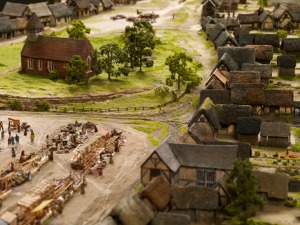
© Birmingham Museums. Depiction of medieval Birmingham at the end of the 13th century, with St Martin’s Church sitting at the centre of the town.
A recent talk I gave for the University of Birmingham’s People, Places and Things series of seminars prompted me to write this latest instalment about medieval Birmingham. In fact, it was a question from a member of the audience after I presented the video of Exploring Medieval Birmingham, 1300 (http://www.youtube.com/watch?v=JZq9cBzrIVI) that determined the topic of this blog. The person in question asked if I’d thought about superimposing images or footage of Birmingham’s present-day streets over the medieval depictions illustrated in the video. Nice idea, and yes, I did think of doing exactly that, but budgetary and time constraints prevented me from doing so, but that isn’t to say that this can’t be achieved in the near future. Nevertheless, until then this blog will attempt to fill a ‘void’ in going half way to doing just that.
The 1296 Borough Rental referred to in my previous blogs on medieval Birmingham mentions around ten streets in the 13th-century town. Not a bad number, considering that Birmingham had roughly only thirty streets 400 years later. Moreover, some of Birmingham’s best-known streets today were already in existence by 1296. This included the likes of Egebastonstret (Edgbaston Street), le Parkestrete (Park Street), Overparkstret (now Moor Street) Novus Vicus (New Street) and Super Montem (the later High Street).
New Street isn’t as new as we might like to think, but certainly existed by the late 13th century. Perhaps it was only recently new then, but equally it could have been a fixture in the medieval town much before this point. While identifying the streets that framed the town, I started to think about their names especially as they can tell us a lot about an area and its ‘lost’ landscape. It’s easy to forget or simply not realise that the original meaning of street names, much like place names, once ‘said’ a lot about a location.
The many different types of street name can reveal an abundance of information relating to topography or geographical location, natural features, types of industries or even people. It seems that the streets that shaped the medieval town of 1296 were largely ‘signposts’ of locational names or topographical features. One example is Super Montem, translating as ‘Upon the Hill’ and this isn’t hard to appreciate when you realise that this part of town really did and does sit at a higher level than the land leading downhill towards St Martin’s and Digbeth, suitably reflected by its current name, High Street. Then there are the convenient indicators of important trading routes such as Edgbaston Street, named after the Anglo-Saxon manor of Edgbaston, meaning Ecgbeald’s Farm. As Edgbaston was seemingly at one time more successful than Birmingham, as indicated by its higher valuation in Domesday Book, it’s perhaps natural that a road should lead to such a neighbouring settlement. After all, it’s very likely that Birmingham’s inhabitants were trading with Edgbaston’s and vice versa and not to forget that Edgbaston Street led to even more important locations like Northfield. Valued at £5 in Domesday, Northfield was one of the more prosperous manors in the wider area, worth five times as much as that of Birmingham. Moreover it was also once owned by the same overlord as Birmingham: William Fitz-Ansculf whose power was centred on Dudley Castle. So perhaps the street also marked the importance of a wider trading route, as well as leading to Edgbaston itself.
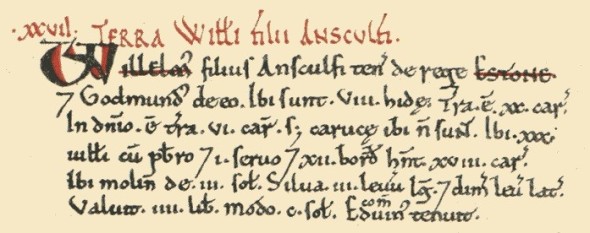
Another important manor also held by William Fitz-Ansculf was Aston, meaning the east estate. Its land and goods were valued at five times that of Birmingham’s at £5 in Domesday Book.
Novus Vicus or New Street is an indicator of Birmingham’s growth and prosperity as new roads were being built presumably to accommodate more inhabitants and trading ventures. Perhaps also, the adjective ‘new’ reflects the age of some of the other streets in the town as they had presumably been in existence for some time to warrant the latest road being called new.
Novus Vicus or New Street is an indicator of Birmingham’s growth and prosperity as new roads were being built presumably to accommodate more inhabitants and trading ventures. Perhaps also, the adjective ‘new’ reflects the age of some of the other streets in the town as they had presumably been in existence for some time to warrant the latest road being called new.
Judging by the question that prompted this blog, people naturally want to know what Birmingham’s oldest streets look like today. It comes as no surprise either that most reside in what is the oldest part of town; the original planned settlement Peter de Birmingham carved out in 1166. This is still one of the busiest parts of Birmingham today bustling with shoppers and inhabitants, now paying their ‘tolls’ and ‘rents’ to a different ‘lord of the manor’. On account of the scale and size we had to adopt for the model of medieval Birmingham, the likes of New Street isn’t featured, so I’ve simply focussed on the streets that are depicted to illustrate what these medieval route ways look like today.
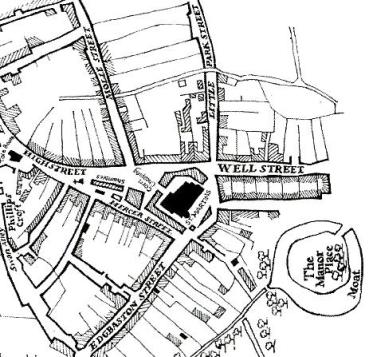
Taken from Birmingham: The Building of a City, the map depicts Birmingham in 1553, but the 12th-century town Peter founded can still be seen. Notice the original triangular shape with four of Birmingham’s earliest roads branching from it: High Street, Edgbaston Street, Molle Street, soon to become Moor Street and Park Street, also at one stage known as Little Park Street.
This brings me on to Edgbaston Street, which in the 13th century was home to surely the smelliest industry in town: leather tanning and judging by the archaeological excavations in the area this trade made the greatest mark upon the industrial endeavours of medieval Birmingham. As an essential material in the Middle Ages, leather goods were a staple of everyday life, as were other goods made from horn and bone, which inevitably grew out of the presence of the tanning trade. Today, Edgbaston Street has exchanged tanning for trading of a different sort, but you can still nevertheless find leather goods, minus the noxious smell, that is. This street is now home to Birmingham’s famous Rag Market, amongst many other traders of mixed enterprise.
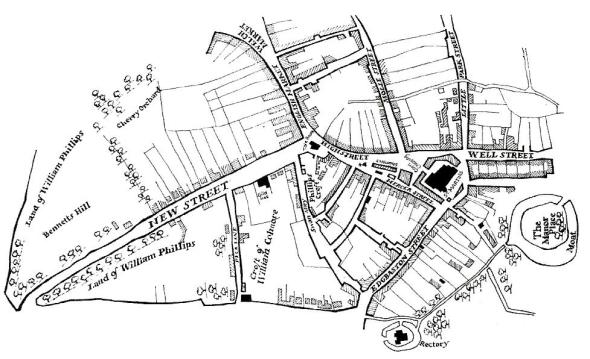
By 1553 the Tudor town had spread down New Street and towards the Priory lands of what is now Bull Street.

© Birmingham Museums. The beginning of Park Street in the 13th-century town around where Selfridges is today.
Park Street or le Parkestrete was developed to make way for the many burgeoning industries, thereby cutting into the lord’s deer park, on what was then the edge of town. Although Park Street no longer lines the periphery of Birmingham, it does in many ways mark the edge of its shopping quarter lying adjacent to Selfridges and its attached car park. In this sense, Park Street is still on the fringe of Birmingham for many, particularly the enthusiastic shopper who merely walks this medieval road in pursuit of one of Birmingham’s biggest twenty-first century industries.
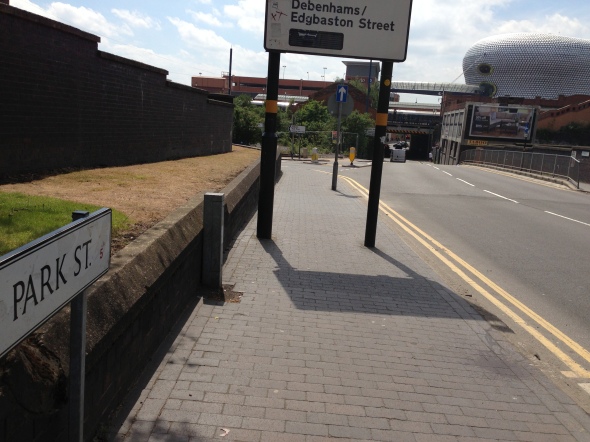
The extent of Park Street today, which actually begins around Selfridges’ car park stretching to just past this point towards Millennium Point.
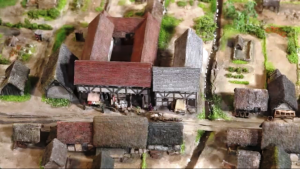
© Birmingham Museums. The beginning of what was to become Moor Street near the eventual site of Selfridges.
Much like Park Street, Overparkstret was also testament to the growth of Birmingham, with the lord once again sacrificing more of his own land for the good of the town, and of course his own pocket. The name is simple and reflects exactly where this new road would lie: ‘over the lord’s park’, or at least part of it. Maybe Overparkstret and Le Parkstret were cut at the same time, maybe they weren’t, but what is clear is that they came into existence to facilitate the expansion of some of Birmingham’s early industries like tanning and pottery making.
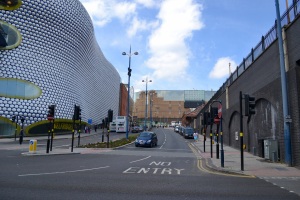
Junction of Park Street and Moor Street where we think Roger le Moul held just some of his numerous burgage plots in 1296.
Perhaps the word park in two of the town’s roads which also lay very close to one another was slightly confusing for its inhabitants and traders, as Overparkstret was eventually renamed. In 1344 we find the earliest known reference to its new name: le Mulestret or Moulestret, in honour of the richest family in town, after the De Birminghams, at least. As we know, le Moulestret is today’s very own Moor Street, becoming the second of Birmingham’s medieval streets to accommodate a train station. We arguably have Roger le Moul to thank for this name change, and it’s indeed ironic that his surname translates as the small when we know he was a man of great property. Owning most of the land in town after William de Birmingham, he certainly ensured that his name and his family’s legacy would forever be preserved in his hometown.
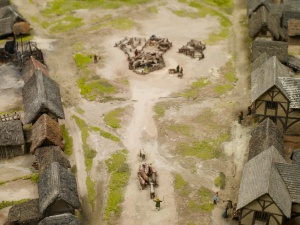
© Birmingham Museums. Start of Super Montem or High Street in 1296. This was no doubt used by drovers to bring their cattle to market in the town.
Last but not least, we finish with Super Montem, now High Street, which is only just visible at the very edge of the scale model. True to its name it still sits on higher ground, which is why I always suggest that people make the effort to stand at the top of High Street and look downhill towards St Martin’s Church. Although the natural topography has been slightly distorted by the most recent Bull Ring developments, you can still get a ‘flavour’ of what the medieval landscape once looked like in terms of its gradient.
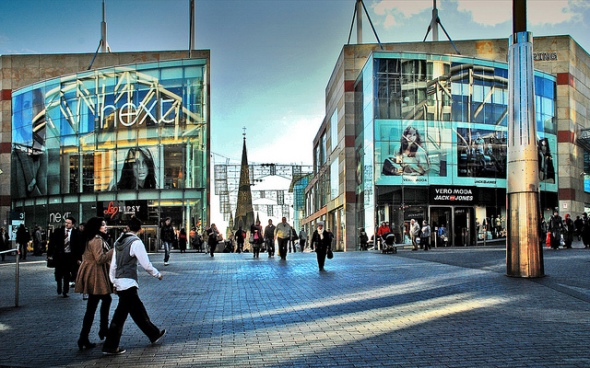
Almost identical to the previous image in terms of position, High Street today is still bustling with shoppers and in the distance St Martin’s steeple peers up towards the higher ground.
Street names are really an excellent starting point for beginning to understand the physical development and topography of places, and sometimes the most ordinary of names, just like Park Street, lying in the most unassuming parts of town, can with a bit of detective work, really reveal a ‘hidden’ or forgotten history of a place. These muted relics of the past can tell us much more than you’d ever imagine, acting as signposts to a displaced landscape or in some cases subtly pointing to a terrain still very much intact, but obscured by the urbanisation of the modern city. Nevertheless, if we take the time to look hard enough, we can develop these ‘negatives’ in to fully-fledged images and create a colourful depiction of these ‘lost’ landscapes.
Sarah Hayes, Freelance Curator
Follow me @HayesSarah17
Your BNA Stories – From Worcestershire to the North American Plains
Posted: May 10, 2013 Filed under: Uncategorized Leave a commentFrom Worcestershire to the North American Plains
Posted: April 10, 2013 Filed under: Uncategorized | Tags: America, American History, Birmingham, Britain, British History, Cavalry, Emigration, Family History, Fort Bayard, History, Native American, New Jersey, New Mexico, New York, Worcestershire Leave a commentNames like the Battle of Little Bighorn, General Custer and Geronimo are recognisable to most of us on account of the great Western movie tradition that has long dominated our television screens. Most people would name the likes of John Wayne or Clint Eastwood when recalling this genre, but if you’re of my generation, one of the most memorable scenes has to be Marty McFly being plunged back to 1885 in the middle of a United States Cavalry pursuit of Native Americans in Back to the Future, Episode III.

Marty McFly desperately trying to ‘outrun’ the ‘Indian’ charge in Back to the Future, Part III . Source: http://movieclips.com/
It’s the noise of hooves pounding the scorched ground and clouds of dust kicked up in the charge, combined with the familiar sound of Native American ‘war cries’ that defines so many depictions of this genre. Most of my knowledge of this period was previously based on the fictional or half-true accounts portrayed in such films, but now the discovery of an ancestor caught up in the renowned American Indian Wars has truly captured my attention.
It all begins with a boy from Worcestershire, Kidderminster to be precise. Henry Rogers Moorby, my first cousin, four times removed was born in 1853 to Edwin and Rebecca Moorby, who incidentally were married in my hometown of Birmingham at St Martin’s in the Bull Ring. When the Moorbys left England for America isn’t yet known, but the birth of a new addition to the family, by the name of Henrietta is recorded in New York in 1858. From this we can presume that Henry was at least five, but probably younger when he left for America with his family. Three years later the family had moved once again, this time to New Jersey. We’ll never really know why the Moorbys set sail for America but as the 1850s were part of one of the biggest waves of immigration to the US from Europe, we can only assume that they too, were in search of a better life in the ‘great land of opportunity’.

New York in the 1850s and a long way from Worcestershire. Was this the New York that greeted the Moorbys? Source: http://hd.housedivided.dickinson.edu/panel
But this isn’t the part of Henry’s life that’s gripped my attention. Instead I need to skip forward to 1876 when Henry was twenty-three years old. Staying true to his nomadic lifestyle, he joins the army, enlisting with the 4th Cavalry in Jersey City. His enlistment papers describe him as 5’5″, fair complexion, grey eyes and brown hair. This was a time of great land hunger and the strong economic developments such as the railway boom of the 1850s and 60s demanded enormous resources. The population had also been nearly doubling every twenty years from 1800 up until this point and the main task of the US army was supporting the government in ‘consolidating’ the nation. But what did that exactly mean? The ensuing government after the Civil War set out to unify America and complete what many nineteenth-century Americans called their manifest destiny, to conquer land from east to west, thereby sowing their ‘superior’ way of life. The idea of exceptionlism fuelled the policies behind the pioneer settlement and gave justification to the removal of an ‘inferior’ race from this newly-conquered land. The Great Plains, where the majority of the army were based in 1876 were simply the missing link in that manifest destiny.

Columbia, the allegorical representation of America is pictured here in John Gast’s American Progress driving settlers and thus ‘civilisation’ westward to colonise new lands. Source:http://en.wikipedia.org/wiki/File:American_progress.JPG
This was frontier land, wild and unruly and ‘up for grabs’ as the US government saw it. The outrage for the many Native American tribes was that they’d been moved here from their native homelands as a result of the Indian Removals Act of 1830. This relocated tribes west of the Mississippi River on what was considered to be poor land with harsh climates, thereby making space for the new white settlers on ‘vacant’ fertile farmland. But east of the Mississippi was quickly becoming overcrowded as the population continued to soar and the insatiable appetite for more territory convinced the government that the lands of the Great Plains weren’t so bad after all. It was this land battle that defined the many struggles of the American Indian Wars.

The missing link in uniting a nation. The red area highlights the Great Plains, traditionally seen as stretching from southern Canada to the southern American states. Source: http://en.wikipedia.org/wiki/File:Map_of_the_Great_Plains.png
As a member of the 4th Cavalry, Henry would have been at the very centre of this conflict as the regiment are known to have been based in the likes of Arizona, South Colorado and New Mexico after 1876; their main duty being to project the pioneer settlers and their lands. But joining the army at this time wasn’t the most appealing of options. It was persistently under-resourced and in 1874 was only 27,000 strong, but responsible for manning two-hundred posts, roughly 135 men if divided equally for each station. The army even made it difficult to spend wages, as troops were paid in paper money which wasn’t yet readily recognised in the West, having to be exchanged at a loss, for coin. Although many recruits may have joined for adventure, it was reported that nearly twenty percent of the army deserted between 1873 and 1876, usually as a result of boredom. Recruits even petitioned Congress in 1878 complaining that their duties simply consisted of building bridges, roads and telegraph lines. But all of these amenities were essential in isolated and vulnerable frontier communities, and the army was crucial in maintaining this new way of life.
Nevertheless there must have been other motivations for joining. The Long Depression had already been raging for three years by the time Henry enlisted and would continue for another three until 1879. One in four labourers in New York and no doubt the situation was worse in New Jersey, were out of work and as a brass moulder, Henry would have suffered the brunt of it. Manufacturing and construction were the main causalities of this recession and with one million unemployed the army must have seemed like a good option. A guaranteed $13 a month for a private in 1876 and the assurance of filling your belly, despite the rations consisting of poor meat, hard bread, beans and strong coffee was seemingly more appealing than life as a civilian.

United States Army recruiting poster, circa. 1876. Source: http://www.crowsnesttrading.com/category/29/2
Another event that presumably acted as perfect propaganda in 1876 was the news of Custer’s defeat at Little Bighorn. But it wasn’t just a defeat, it was an annihilation of 268 men from the 7th Cavalry at the hands of the Lakota Sioux and Cheyenne warriors led by Sitting Bull. The reaction was one of outrage and shock, and the timing couldn’t have been worse. The news would have reached the American public during the celebration of the nation’s centennial. America was a hundred years old and for all its economic and political ‘superiority’ it had just been defeated by what many saw as a primitive people standing in the way of natural progression. There’s much more to this story, namely in the fact the Native Americans weren’t primitive at all and grossly underestimated. But the point of mentioning it here is to colour the background and frame the political scene of the America that Henry was living in when he enlisted. The legend of Custer must have played a part in persuading young patriotic men to enlist. Henry did, after all join just four months after the infamous battle and this together with poor economic prospects probably fuelled his decision to abandon civilian life.

Lakota Chief, Sitting Bull, led more than 2,000 Native American warriors against Custer’s 7th Cavalry at the Battle of Little Bighorn in 1876. Source: http://northdakotacowboy.com
The story skips forward here yet again to April 25th 1882, when Henry, now a sergeant aged just twenty-nine years old died ‘of wounds in action with Indians on cars between Lordsburg and Separ, New Mexico’. It was the description of being killed by ‘Indians’ that initially caught my attention and led me to believe that there was something more behind the story. Granted, there were many small battles and skirmishes between cavalry and ‘Indians’ during this period, but even a skirmish can make the newspapers. Lo and behold, a simple search of ‘Lordsburg 1882’ revealed an abundance of sources from books, but more decisively generated newspaper articles, including one from the Sacramento Daily Record-Union reporting on Henry’s death. It places Henry in a conflict with Apaches on April 23rd 1882 that’s frequently referred to as the Battle of Horseshoe Canyon or Doubtful Canyon. Colonel Forsyth, who was present at the battle reported that:
This perfectly supports other accounts from that day, namely that ‘Forsyth raced up with Companies C, F, G, H and M of the 4th cavalry.’ The colonel’s call for reinforcements would spell the fateful demise of Henry as he was caught up in the subsequent gun battle with Apache warriors and shot ‘through the left lung just below the heart; the wound being probably fateful’ and it was. Of course the ‘probably fateful’ explains why he died two days after the attack ‘on cars between Lordsburg and Separ’ as Forsyth sent the wounded by train to the former for treatment. Henry, no doubt was on one of those carriages, dying before he reached the town.
A search of the U.S. Registers of Deaths in the Regular Army, 1860-1889 for Henry confirms his cause of death noting that he died of ‘gunshots of chest’.

Henry’s cause of death noted in the U.S. Registers of Deaths in the Regular Army, 1860-1889. Source: http://www.ancestry.co.uk/
In other accounts, and indeed Forsyth’s own, there is very little about the four Indian scouts and private who were killed. But a simple search of the same register of those who died on 23rd April 1882 discloses the names, confirms the ranks and states the place of death of these five men. Forgotten by history in one sense, they are perfectly preserved in another, and can be ‘written back in’ to this story. Yuma Bill, Kaloh Vichajo, Panocha and Ceguania are revealed as the four scouts, along with Private, William Kurtz, also part of C Company with Henry, who all died at Stein’s Peak on 23rd April. Details around the scouts’ deaths are more limited mentioning only that each had ‘died in action with hostile Indians’ as Yuma Bill’s entry below shows:

‘Indian’ Scout, Yuma Bill or Bill Yuma recorded as dying at Stein’s Peak where McDonald and his contingent were attacked. Source: http://www.ancestry.co.uk/

A search on Ancestry.co.uk of the U.S. Registers of Deaths in the Regular Army, 1860-1889 reveals the five men killed at Stein’s Peak on 23rd April 1882. Source: http://www.ancestry.co.uk/
However, if the passage from the Encyclopedia of Indian Wars below is taken to be true, the circumstances around the scouts’ deaths are all the more tragic as they were initially reluctant to follow their general into Stein’s Peak:

‘Indian’ scouts, Company C Arizona, 1882. They were first authorised as members of the U.S. Army in 1866 and provided vital knowledge of local terrain and Native American tribes. Source: http://www.westernerspublications.ltd.uk
It would be naive to assume that this is an objective account and the phrase ‘cowardly’ is equally problematic, but nevertheless in terms of confirming the number of scouts killed and the presence of Yuma Bill, it perfectly supports the report from the Record-Union. As for William Kurtz, if Henry can be described as ‘lucky’ for surviving two days after the battle, the private was desperately unfortunate being shot in the head and no doubt dying instantly.
Henry’s story ends at Fort Bayard, now a national cemetery in New Mexico where he’s buried. This, however, wasn’t his first resting place as he was reinterred at Bayard on 9th May 1884 having been moved from an earlier point, still to be determined. As for the other five men, no records of their burials appear, but considering that the army would very often bury the dead where they fell, chances are they are resting somewhere very near Stein’s Peak today. Who’s remembered and who’s forgotten has always fascinated me and this story proves not so much that history is written by the victors, but more that rank and position frequently make the headlines. For me, history is an abridged version of the past missing many detailed footnotes. Yet, social history which has been described as ‘the history with people put back in’ has always been my starting point for understanding the bigger narratives of the past. By ‘getting to know’ the likes of Henry and adding names to the nameless, I’m able to appreciate the human story behind this bigger chapter of events. Although we think we ‘know’ history, we are often more acquaintances than good friends, but by trying to understand the actions and motivations of the people involved, just like those in the skirmish of Horseshoe canyon, we can infuse colour back into a faded picture of the past.
Sarah Hayes, Freelance Curator
Follow me on Twitter @HayesSarah17







